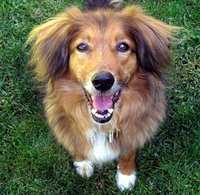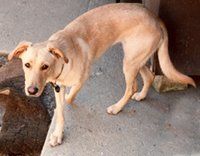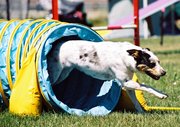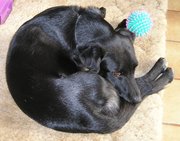Mixed-breed dog
|
|

A mixed-breed dog (also called a mutt, crossbreed, mongrel, tyke, cur, or random-bred dog, often depending on the circumstances of its breeding) is a dog that is a mixture of two or more breeds. Mixed-breed dogs vary in size, shape, and color, making them hard to classify physically. Historically, all purebred dogs have been selected from a mixed-breed population. See Golden Retriever for an example. Further, except for extreme variations in size, dogs breed without concern for genetic heritage.
| Contents |
Terms for mixed-breed dogs
There is a profusion of words and phrases used for non-purebred dogs. The words cur, tyke, and mongrel are generally viewed as derogatory in America, whereas in the United Kingdom mongrel is the unique technical word for a mixed-breed dog, and is not a term of disparagement when referring to a dog. Therefore, many American owners prefer mixed-breed. Mutt is also used (in the U.S.A and Canada), sometimes in an affectionate manner. In Hawaii, mixed breed dogs are referred to as poi dog. Some American registries and dog clubs that accept mixed-breed dogs use the breed name All American, referring to the United States' reputation as a melting pot of different nationalities. Random-bred dog, mutt, and mongrel are often used for dogs who result from breeding without the supervision or planning of humans, especially after several generations, whereas mixed breed and crossbreed often imply mixes of known breeds, sometimes deliberately mated.
Slang terms are also common. Heinz 57 is often used for dogs of uncertain ancestry, in a playful reference to the "57 Varieties" slogan of the H. J. Heinz Company. In some countries, bitsa is common, meaning "bits o' this, bits o' that". A fice or feist is a small mixed-breed dog.
To complicate matters, many owners of crossbred dogs identify them—often facetiously—by an invented breed name constructed from parts of their parents' breed names. For example, a cross between a Pekingese and a Poodle is called a Peekapoo, possibly a play on peek-a-boo. As another example, one of England's Queen Elizabeth's famous Corgis mated with her sister's Dachshund, and the resulting offspring are referred to as Dorgis. Many dogs in New York City which might previously have been described as Shepherd mixes are now referred to colloquially as Brooklyn Shepherds.
Appearance

All possible body shapes, ear types, and tail styles can appear in mixed breeds. Extremes in appearance, however, such as the flattened face of the English Bulldog or the extremely curled tail of the Pug, seldom survive even the first crossbreeding. Mixed breeds also tend to have a size between that of their parents, thus tending eventually toward the norm.
Mixed-breed dogs can be any size, weight, or color, but some colors are more common than others. No matter their parents' colors, mixed breeds are often a light-to-medium brown or black, frequently with a white chest and other white markings. The light-brown coat is sometimes called yellow, as personified by the fictional dog Old Yeller. A brown coat with black across the top and sides is also quite common.
Predicting the adult appearance of a mixed-breed puppy is difficult. Even purebred puppies do not look much like the adult dogs they will become, and with mixed-breed puppies it is nearly impossible. If one knows the breeds of the parents, some characteristics can be ruled out; for example, a cross between two small purebreds will not result in a dog the size of a Great Dane. Some breeds tend to pass on their physical traits to mixes more than others. Border Collies and some Spaniels, for example, often produce offspring with similar coats and ears. The crossbred offspring of German Shepherds usually have Shepherd faces and other characteristics.
This mixed-breed might have a terrier ancestor or a long-haired breed such as a Bearded Collie—but it is impossible to know without having seen the parents.]] With each generation of indiscriminate mixing, the offspring move closer to the genetic norm. Dogs that are descended from many generations of mixes are typically light brown or black and weigh about 18 kg (40 lb). They typically stand between 38 and 57 cm (15 and 23 inches) tall at the withers.
Guessing a mixed-breed's unknown ancestry is difficult for even knowledgeable dog observers, because mixed breeds have much more genetic variation than among purebreds. For example, two white mixed-breed dogs might have recessive genes that produce a black coat and, therefore, produce offspring looking unlike their parents.
Health
The theory of hybrid vigor suggests that dogs of mixed ancestry will be healthier than their purebred counterparts. In some cases this might be true, because inbreeding among purebreds has made some breeds prone to various genetic health problems. Mixed-breed dogs are less likely to have certain genetic disorders, as their parents come from a more diverse genetic pool so that detrimental recessive genes are less likely to occur in both parents. For example, large dogs such as German Shepherd Dogs often suffer from hip dysplasia. Mating a German Shepherd carrier of the faulty gene with a dog from a breed not known to suffer genetic hip problems reduces the likelihood of producing offspring with the problem. On the other hand, breeding the Shepherd with another Shepherd whose ancestors do not have the genetic problem also has this effect.
Some purebred dog breeds have difficulties associated simply with the exaggerated physical traits of the breed. For example, the French Bulldog has such small hips and such a large head that artificial insemination and Cesarian section are usually required to produce puppies. Crossing such a dog with another breed will likely produce dogs without these reproductive difficulties, although most authorities on dog populations discourage reproduction among crossbreeds and mixed breeds because there are already so many purebreds available for adoption in addition to mixed breeds.
There is no guarantee of good genetic health of any dog, purebred or otherwise, as not all damaging genes are recessive. Also, of course, purebred and mixed-breed dogs are equally susceptible to nongenetic ailments, such as rabies, distemper, injury, and infestation by parasites.
Types of mixed breeding
It's important to note that all dog breeds are man-made creations: dogs were traditionally bred for specific functions. All existing dog breeds began as mixed breeds, either by random occurrence or by deliberate crosses of existing breeds. Encouraging desirable traits and discouraging others, breeders sought to create their ideal appearance or behavior, or both, for dogs, and, additionally, to ensure that the dogs could consistently produce offspring with the same appearance or behavior. Some consider mixed breeds undesirable, but mixing breeds can lead to desirable results, especially in the hands of an expert breeder. On the other hand, inexperienced crossbreeders can produce disastrous results. For example, the offspring of an obsessive Border Collie and an energetic, destructive Terrier could be dogs whose behavior is so erratic as to make the dogs a liability.
Mixed-breed dogs can be divided roughly into three types:
- Crossbred dogs, which are mixtures of two known breeds. Some crossbreeds have traits that make them popular enough to be frequently bred deliberately, such as the Cockapoo—a cross between a Poodle and a Cocker Spaniel—and the Goldendoodle, which mixes a Golden Retriever with a Poodle. Other crossbreeds occur when breeders are hoping to create new breeds or to add or reinforce characteristics from one breed into another breed. Most crossbreedings, however, occur accidentally.
- Mixes among more than two breeds, such as when a crossbred dog mates with a purebred dog or with another crossbreed. The term mongrel is sometimes used to distinguish these dogs from crossbreeds.
- The generic canis familiaris, seen in feral or pariah dog populations, where mixed breeding has occurred over many generations. These dogs tend to be light brown and of medium height and weight. This "genetic average" might also represent the appearance of the modern dog's ancestor.
There is no scientific justification for the belief that a purebred bitch is in any way tainted after mating with a dog of another breed. Future matings with dogs of the same breed will produce purebred puppies.
Mixed breeds in dog sports

Both purebred and mixed-breed dogs can excel at dog sports, such as obedience, dog agility, flyball, and frisbee. Often, highly energetic mixed-breeds are left with shelters or rescue groups, where they are sought by owners with the caring, patience, and drive to train them for dog sports, turning unwanted dogs into healthy, mentally and physically stimulated award winners.
Historically, dog shows and dog sports excluded mixed-breed dogs from competition. While this tradition is changing, some sports still remain open only to one breed of dog, such as greyhound racing, or to one type of dog, such as sheepdog trials open only to dogs of known herding ancestry. In the latter case, herding organizations now sometimes accept mixed-breed dogs who have evident herding-dog ancestry, such as Corgi mixes or Border Collie crosses.
Until the early 1980s, mixed-breed dogs were also generally excluded from obedience competitions. However, starting with the American Mixed Breed Obedience Registry (AMBOR) and the Mixed Breed Dog Club of America (MBDCA), which created obedience venues in which mixed-breed dogs could compete, more opportunities have opened up for all dogs in all dog sports. Most dog agility and flyball organizations have always allowed mixed-breed dogs to compete. Today, mixed breeds have proved their worth in many performance sports.
Some kennel clubs, whose purpose is to promote purebred dogs, still exclude mixed breeds from their performance events. The AKC and the FCI are two prominent hold-outs. However, the AKC does allow mixed breeds to earn their Canine Good Citizen award.
In dog shows, where dogs' conformation is evaluated, mixed-breed dogs normally cannot compete. For purebred dogs, their physical characteristics are judged against a single breed standard. Mixed-breed dogs, however, are difficult to classify except according to height; there is tremendous variation in physical traits such as coat, skeletal structure, gait, ear set, eye shape and color, and so on. When conformation standards are applied to mixed-breed dogs, such as in events run by the MBDCA, the standards are usually general traits of health, soundness, symmetry, and personality.
Advantages and drawbacks
The mature appearance and behavior of purebred puppies is more predictable than that of mixed breeds, including cross-breeds. With purebred dogs, the genetic variations are well documented and a breeder has a fair estimation of what type of offspring a given pair will produce. Even still, there is variation within breeds; for example, two champion sheep-herding Border Collies might produce offspring with no interest in sheep herding.
Mixed breed dogs are, on average, no more intelligent than purebred dogs, and both sets feature both slow learners and dogs with high learning capacity. For example, Benji, the hero in a series of films named for him, was a mixed-breed terrier. However, it is more difficult to predict the trainability of mixed-breed dogs when they are very young. Most Golden Retrievers are eager to please, but a mix of a Golden with the independent Siberian Husky could inherit either dog's trainability—or you could get a dog with the endurance and athleticism of the Siberian and the trainability of the Golden.

Many people enjoy owning mixed breeds, valuing their unique appearance and characteristics; while dogs of some breeds, such as the Tervueren, exhibit little variability of appearance, mixed-breed dogs exhibit often unique appearances. Although some dog owners have a specific breed of dog they wish to acquire, and will never accept a mixed breed, many others enjoy mixed-breed dogs that exhibit characteristics similar to their favorite breeds; in fact, with a mixed breed, they can enjoy some aspects of appearance and personality of two favorite breeds with a single dog.
There is usually an abundant supply of mixed-breed dogs wanting owners, available at negligible prices, while pedigreed dogs can cost hundreds or thousands of dollars and reputable breeders can be hard to find.
Some owners value a dog's pedigree as a status symbol and, therefore, have no use for mixed-breed dogs, whose market value is effectively zero; others particularly appreciate the physical or behavioral traits of certain breeds; still others ignore pedigree and, instead, value a dog's personality and health. In short, most dog owners believe that their dog's breed—and specifically his or her own dog—is the best sort of dog there is.
See also
Dog Pictures and Clipart
- Pictures of Dogs (http://classroomclipart.com/cgi-bin/kids/imageFolio.cgi?direct=Animals/Dogs)
- Dog Clipart (http://classroomclipart.com/cgi-bin/kids/imageFolio.cgi?direct=Clipart/Animals/Dog_Clipart)
Clipart and Animal Pictures
- Clipart (https://classroomclipart.com/image/category/clipart.htm)
- Animal Clipart (https://classroomclipart.com/image/category/animal-clipart.htm)
- Animal Animated Clipart (https://classroomclipart.com/clipart/Animations/Animals.htm)
- Pictures of Animals (https://classroomclipart.com/image/category/animal-photos.htm)
- Amphibian Clip Art, Pictures and Photogaphs (https://classroomclipart.com/image/category/amphibian-clipart.htm)
- Farm Animal Clip Art, Pictures and Photographs (https://classroomclipart.com/image/category/farm-animal-clipart.htm)
- Mammal Clip Art, Pictures and Photographs (https://classroomclipart.com/image/category/mammal-clipart.htm)
- Marine Animal Clip Art, Pictures and Photographs (https://classroomclipart.com/image/category/marine-life-clipart.htm)
- Reptile Clip Art, Pictures and Photographs (https://classroomclipart.com/image/category/reptile-clipart.htm)
- Spider Clip Art, Pictures and Photographs (https://classroomclipart.com/image/category/spider-clipart.htm)


